Find out how brands are using interactive advertising to boost reach and engagement with these 4 examples of successful interactive advertising.

When Pokemon Go launched in 2016, it topped app charts with a record-breaking 130 million downloads and over $206 million dollars in sales within its first 4 weeks.
Marketers took notice of the game?s impressive use of interactive content and began experimenting with ways to apply that appeal to advertising.
Partially as a result of Pokemon Go?s success, we?re now on our way to a new era in digital marketing ? one that directly engages audiences through interactive technologies such as augmented reality, virtual reality, and artificial intelligence.
According to a survey by Content Marketing Institute, 88% of marketers believe interactive content is effective at differentiating their brands from competitors.
In this article, we take a look at some examples of successful interactive advertising to find out what small businesses can learn from some of the most successful campaigns.
- What is Interactive Advertising?
- Budweiser Sends Fans Searching
- Ikea Offers Pregnancy Test In Print Ad
- Lego And Hulu Offer User-controlled Experiences
There are many types of interactive advertising. The examples we?ve chosen offer valuable lessons for small- to medium-sized businesses looking to implement simple but effective tactics for highly-engaged campaigns.
What Is Interactive Advertising?
The term ?interactive advertising? has been defined and redefined a number of times throughout the years. As interactivity becomes a more natural way for marketers to connect with audiences, the term is now simple to understand.
Interactive advertising is anything that encourages the target audience to interact with advertising, marketing, or promotions. It turns traditional advertising into an activity that encourages the audience to do something, rather than view the ad passively.
There are many ways businesses create interactive advertising, such as:
- Augmented reality
- Virtual reality
- Quizzes
- Responding to questions
- QR codes
Let?s take a look at how some of these technologies are incorporated into successful marketing campaigns.
Budweiser Sends Fans Google Searching
One of Brazil?s largest ad agencies, ?Africa,? took a risk on an innovative approach to interactive advertising that paid off. Budweiser?s ?Tag Words? campaign went so well that it won one of the highest global honors in the advertising industry ? the Grand Prix in Print and Publishing at Cannes Lions 2018 festival.
Small businesses aren?t the only ones on a budget.
Even a brand as big as Budweiser couldn?t afford to pay licensing fees on all the images of rocks stars who, throughout history, were photographed drinking Bud beer.
In its ?Tag Words? campaign, ads instructed fans to search for specific keyword phrases.
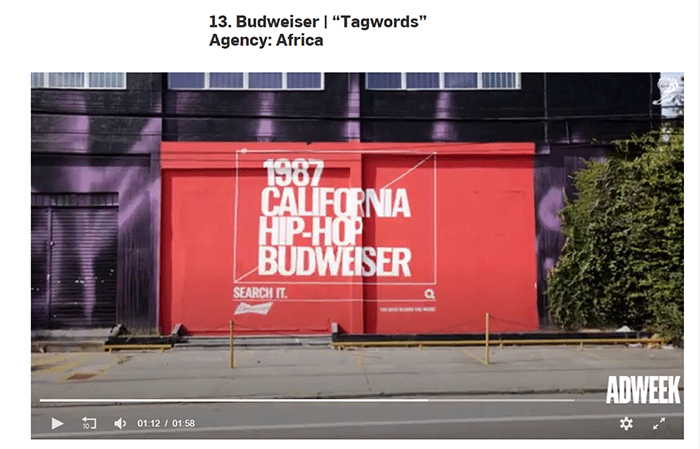
The search tags then brought searchers to images of different celebrities drinking or holding a Budweiser beer.

For example, a search for ?1960 flying v slide Budweiser? brings up images and mentions of Jimi Hendrix using a can of Budweiser to play his slide guitar.
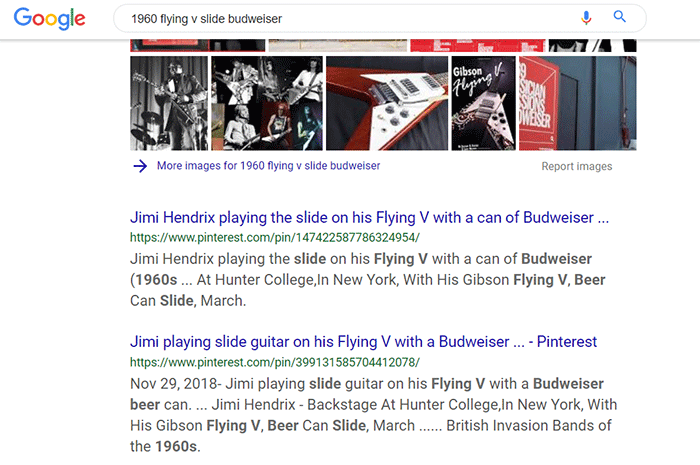
Budweiser?s campaign was a simple yet highly creative approach that didn?t require sophisticated technology or an outrageous budget.
Viewers responded well to the campaign and Google-searched the key phrases as if it they were part of a rock-n-roll scavenger hunt.
Sometimes budget constraints inspire teams to push the boundaries of creativity further, resulting in more success than high-dollar marketing.
This is an excellent lesson for small businesses looking to create engaging interactive campaigns on a modest budget.
Ikea Offers Pregnancy Test In Print Ad
When Ikea published a print ad that included a pregnancy test, news of its launch quickly went viral, thanks to its ?Pee on this ad? headline.
Was it creative genius or simply repulsive? At first the internet couldn?t decide, but the whole world was talking about it anyway.
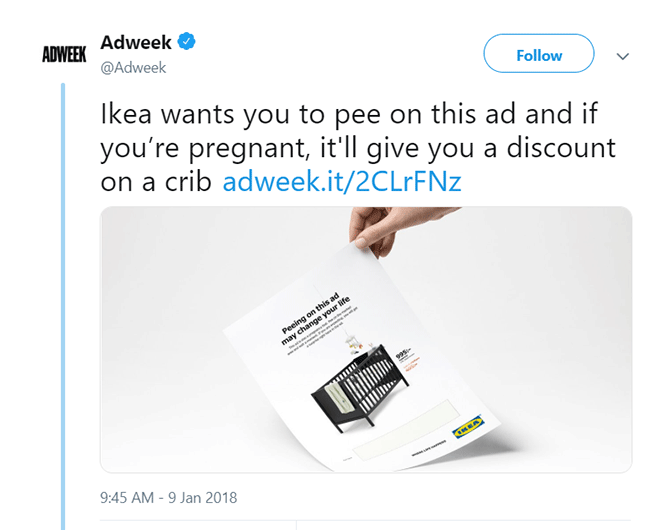
Ikea?s crib ad doubled as a pregnancy test that revealed a hidden discount if the test results were positive. Fortunately, the coupon didn?t need to be presented at the time of purchase, since the ad only showed the cribs? reduced price.
Media broadcasters, writers, and reporters couldn?t get enough of it.
The ad presented a chance for the media to laugh, insinuate, and play with words in a way that offered a humorous break from normal day-to-day news stories.
The Independent called it ?the future of advertising,? while Mashable described the ad as ?genius, hilarious, and also wonderfully gross.?
Ikea?s interactive campaign earned 4.3 billion impressions and nearly $12 billion worth of earned media.
While the technology to run an ad with this type of medical technology is out-of-reach for most businesses, the pregnancy test isn?t the only thing that made this one famous.
Ikea?s ability to inspire bloggers, broadcasters, writers, and talk show hosts is part of the reason its campaign was so profitable.
When your brand can offer the media a fresh and fun opportunity to connect with their own audiences, they?re more likely to pay attention.
Discover how to fuse TV and social media for advertising success.
Lego and Hulu Offer Viewer Choices
Lego?s ?Slimy Situation? video ad offers users a choice of endings to a dramatic Lego city story.
Catering to its target audience, Lego?s one-minute drama begins with a Lego-crafted village in which a small Lego character purchases a cup of coffee from the town coffee shop.
Seconds later, Slime begins pouring into the town as if it were volcano lava.
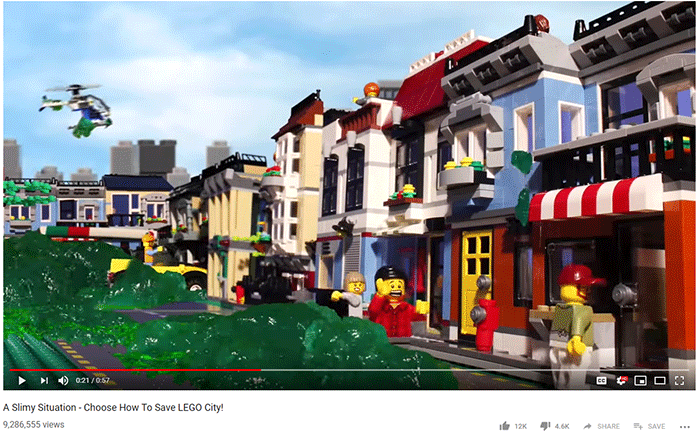
Soon, all the townspeople are running from the slime, and just as it?s about to reach them, the video stops.
Next, viewers choose how the story will develop:
- Get to the Choppa!
- Hide it
- Suck it up
All 3 endings offer a different way to save the village, but the viewer gets to choose how they?ll be rescued.
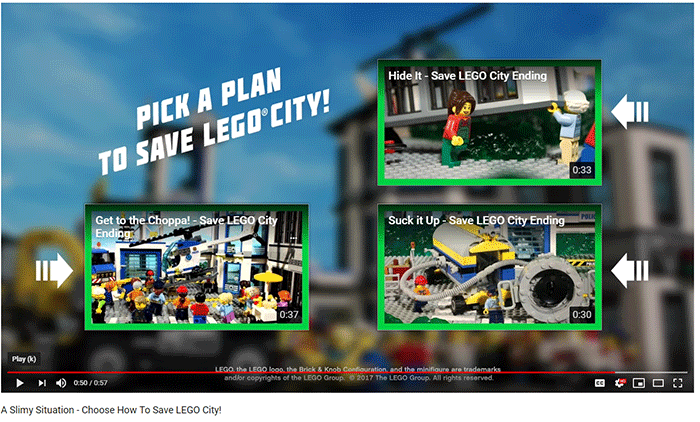
Hulu subscription service has built and developed its business model on interactive choices like the ones above.
Knowing that its target audience prefers to control its viewing experience by selecting shows and watching at its convenience, Hulu expanded on that idea when it began offering ad choices.
Hulu viewers can often choose their own ad experiences, such as watching ads at commercial breaks or viewing them all at once for an ad-free episode. It also offers to lower the amount of time viewers spend watching ads in a show if they?re willing to interact with a commercial ahead of time.
Now, Hulu is adding even more interaction in its ads with movie trailers that allow viewers to purchase movie tickets from the ad.
According to Hulu VP and head of research Julie DeTraglia, this type of choice and interaction offers a lift to all its key branding metrics.
Pairing interaction with choices is an approach that works well for both Lego and Hulu.
When creating videos, alternate endings are an easy feature to add by simply adding links, the way that Lego does, at the end of the video.
There are many ways to add choices to your advertising, including allowing readers or viewers to tailor the product to one they might be interested in.
Interactive Advertising Turns Passive Viewers Into Active Participants
Interactive advertising allows you to gamify or personalize advertising for your brand. This turns a passive-viewing experience into an activity that helps you connect and form memories with your audience.
While some interactive advertising is built on new technology such as virtual reality or the latest medical testing innovations, these aren?t required for success.
A successful interactive ad campaign can be simple and affordable, and is within reach for all businesses.
This article was originally published on The Manifest on January 25, 2019 and was written by Rhonda Bradley.


